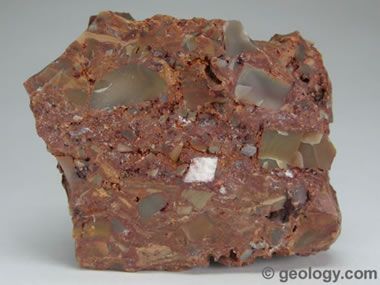Evaluating "Puddingstone"
Downtown Orting looks much like any other suburban area in this part of Washington - small schools, cookie cutter homes, and a small downtown area. In fact, depending on the time of year, you might just hear the hometown football team score a touchdown as you collect the necessary information for this Earthcache.

Hidden among this small town is an interesting boulder which can help demonstrate some interesting geological phenomenon. As you read the description below and make your observations at the coordinates, please keep in mind that this is an Earthcache - as such there is no physical container to locate here and no log to sign. Rather you can claim your smiley by answering the questions below in a message to the CO!
As you arrive at the posted coordinates, you'll see a large rock sitting in the green space next to the sidewalk. You might notice some oddities about it - it's not uniform in nature and looks like hundreds of smaller rocks held together by some sort of bonding agent - they are colloquially known as Puddingstones. You're looking at a clastic rock, which comes in two distinctive clastic classes* - Conglomerates and Breccia.
Conglomorates
Conglomorates are a clastic sedimentary rock that contains large rounded clasts/rocks. The space between the clasts is filled with smaller particles and can include calcite or quartz cement that binds the rock. Clasts are normally larger than 2 mm, and can include pebbles, cobbles and small boulders. The clastic material can be made up of any type of rock or mineral including quartzite, sandstone, limestone, granite, basalt, gneiss, as well as mineral particles such as quartz or feldspar. The clasts themselves can come from sedimentary, metamorphic or igneous rock fragments. These fragments are often rounded and smooth from being washed downstream or in a current as a result of mechanical weathering. Conglomerate matrix binding the clasts together can be a mixture of sand, mud and chemical cement
boulders. The clastic material can be made up of any type of rock or mineral including quartzite, sandstone, limestone, granite, basalt, gneiss, as well as mineral particles such as quartz or feldspar. The clasts themselves can come from sedimentary, metamorphic or igneous rock fragments. These fragments are often rounded and smooth from being washed downstream or in a current as a result of mechanical weathering. Conglomerate matrix binding the clasts together can be a mixture of sand, mud and chemical cement
Breccia
Breccia is formed in a very similar fashion to conglomerate and to be considered a breccia the clasts must also be at least 2mm in size. The main  difference between the two rocks is that breccia's rock fragments are very sharp and angular. They are also a clastic sedimentary rock composed of broken fragments of minerals held together by a fine grained matrix. Breccias however, are consolidated rubble. The word has its origins in the Italian language, in which it means either "loose gravel" or "stone made by cemented gravel. The cementing agents silica, calcite (CaCO3), and iron oxides are the same as in conglomerate. Typically, these rock fragments have not been transported by water, wind, or glaciers long enough to be rounded and smoothed like in the conglomerate.
difference between the two rocks is that breccia's rock fragments are very sharp and angular. They are also a clastic sedimentary rock composed of broken fragments of minerals held together by a fine grained matrix. Breccias however, are consolidated rubble. The word has its origins in the Italian language, in which it means either "loose gravel" or "stone made by cemented gravel. The cementing agents silica, calcite (CaCO3), and iron oxides are the same as in conglomerate. Typically, these rock fragments have not been transported by water, wind, or glaciers long enough to be rounded and smoothed like in the conglomerate.
Cementing Actions
Regardless of if a stone is a conglomorate or a breccia, the cementation and compaction are the two processes that bind the clasts together in one sedimentary layer. The first process, compaction, aids in forming the rocks by squeezing together layers of sediment and reducing the thickness of the pore spaces around the clasts and sediments, which will lead to a tighter packed layer. From there the next process, cementation, changes the individual clastic pieces into rock by filling spaces around the larger clastics with smaller sediments and minerals. Common minerals that help with the cementation process are calcite and silica. The cementing agents found in both breccia and conglomorates include silica, calcite (CaCO3), and iron oxides.

Logging Requirements
To log this earthcache you must answer the following questions and send your answers to the CO. Please do not include your responses in your log. Once you've sent off your answers you are free to log this earthcache!
- Examine the rock in front of you. Estimate how large the average clast is. Does it meet the requirements to be considered breccia or conglomorate?
- Examine the rock in front of you. Are the individual clasts more angular or more rounded?
- Based on your reading above, what does this tell you about the history of the boulder in terms of weathering?
- Classify the rock as either breccia, conglomorate, or neither.
References:
- https://rocksminerals.flexiblelearning.auckland.ac.nz/rocks/breccia.html
- https://geology.com/rocks/conglomerate.shtml
- https://geology.com/rocks/breccia.shtml
* Try saying that tongue twister three times fast!